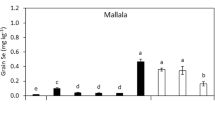Abstract
The effects of various selenium concentrations on crop formation, grain quality, and nitrogen and selenium accumulation in spring barley grown on sod–podzolic soil were studied in experiments on vegetation. Optimal amounts of the element were established taking into account different levels of mineral nutrition (NPK) for enriching barley production. Positive effects of selenium on yield, grain quality, and other features of its action on plants were noted. The key role of mineral fertilizers in the effectiveness of foliar treatment of barley was studied.
Similar content being viewed by others
References
Antipov, V.A., Rodionova, T.N., Belyaev, V.A., et al., Selen v zhivotnovodstve i veterinarii (Selenium in Animal Production and Veterinary), Kazan, 2012.
Vikhreva, V.A., Blinokhvatov, A.A., and Kleimenova, T.V., Selen v zhizni rastenii (Selenium in Floral World), Penza, 2012.
Golovatskaya, I.F., Kulagina, Yu.M., and Krakhaleva, A.V., Effect of selenium and sodium selenate onto Irgin wheat growth and productivity depending on processing procedure, Vestn. Tomsk. Gos. Pedagog. Univ. Biol., 2012, no. 7.
Golubkina, N.A., Fluorometric way to detect selenium, Zh. Anal. Khim., 1995, vol. 50, no. 5, pp. 492–497.
Golubkina, N.A. and Papazyan, T.T., Selen v pitanii. Rasteniya, zhivotnye, chelovek (Selenium in Food. Plants, Animals, Human), Moscow, 2006.
Egorov, V.V., Fridland, V.M., and Ivanova, E.N., Klassifikatsiya i diagnostika pochv SSSR (The USSR Soils Classification and Diagnostics), Moscow, 1977.
Katashov, D.A. and Khryanin, V.N., Phytohormones and sodium selenate effect onto mitotic activity of rape (Brassica napus) germinant roots apical meristems), Izv. Vyssh. Ucheb. Zaved. Povolzhsk. Region. Estestv. Nauki, 2013, no. 2.
Praktikum po agrokhimii (Practical Works on Agriculture Chemistry), Mineev, V.G., Ed., Moscow, 2001.
Seregina, I.I., Nilovskaya, N.T., and Ostapenko, N.V., Selenium role for formatting the summer wheat corn harvest, Agrokhimiya, 2001, no. 1.
Televka, M.S., Selenium role for forming summer wheat productivity under stress conditions, Extended Abstract of Cand. Sci. (Agric.) Dissertation, Moscow, 2013.
Tret’yak, L.N. and Gerasimov, E.M., Specificity of selenium effect onto human and animal organisms. In application to the problem on producing seleniumcontaining food, Vestn. Orenb. Gos. Univ., 2007, no. 12.
Yakovlev, P.A., Microelements effect onto nitrogen metabolism and onto triticale and wheat resistance against environmental stress factors, Extended Abstract of Cand. Sci. (Biol.) Dissertation, Moscow, 2014.
Aro, A., Alfthan, G., and Varo, P., Effects of supplementation of fertilizers on human selenium status in Finland, Analyst, 1995, no. 120.
Ermakov, V.V., Problems of extremal geochemical ecology and biogeochemical study of the biosphere, in Biogeochemistry and Geochemical Ecology, Moscow: GUN NPC TMG MZ, RF, 2001, pp. 98–144.
Gissel, G., Selenium fertilizers and foliar application, Danish experiments, Ann. Clinic. Res., 1986, vol. 18, no. 1, pp. 61–64.
Golubkina, N.A., Selenium accumulation by cereals in Russia, Russ. Agric. Sci., 2007, vol. 33, no. 5.
Guptai, U.C., McRae, K.B., and Winter, K.A., Effect of applied selenium on the selenium content of barley and forages and soil selenium depletion rates, Can. J. Soil Sci., 1982, vol. 62, no. 1, pp. 145–154.
Nawaz, F., Ahmad, R., Ashraf, M.Y., et al., Effect of selenium foliar spray on physiological and biochemical processes and chemical constituents of wheat under drought stress, Ecotoxicol. Environ. Safety, 2015, vol. 113, pp. 191–200.
Pilon-Smits, E.A.H., Bañuelos, G.S., and Parker, D.R., Uptake, metabolism, and volatilization of selenium by terrestrial plants, in Salinity and Drainage in San Joaquin Valley, Chang, A.C. and Brawer Silva, D., Eds., Dordrecht, 2014, vol. 5.
Tan, J., Zhu, W., Wang, W., et al., Selenium in soil and endemic diseases in China, Sci. Total. Environ., 2002, vol. 284, nos. 1–3, pp. 227–235.
Terry, N., Zayed, A.M., Souza, M.P., and Tarun, A.S., Selenium in higher plants, Annu. Rev. Plant Physiol. Plant. Mol. Biol., 2000, vol. 51, pp. 401–432.
Author information
Authors and Affiliations
Corresponding author
Additional information
Original Russian Text © A.P. Kiryushina, L.P. Voronina, 2017, published in Vestnik Moskovskogo Universiteta, Seriya 17: Pochvovedenie, 2017, No. 2, pp. 13–18.
About this article
Cite this article
Kiryushina, A.P., Voronina, L.P. Foliar treatment of barley by sodium selenium in controlled conditions. Moscow Univ. Soil Sci. Bull. 72, 61–65 (2017). https://doi.org/10.3103/S0147687417020041
Received:
Published:
Issue Date:
DOI: https://doi.org/10.3103/S0147687417020041




